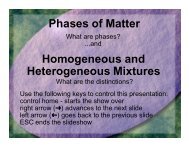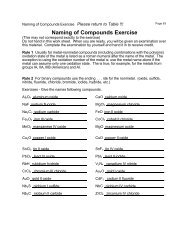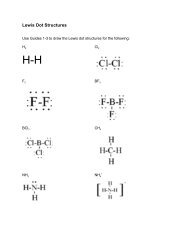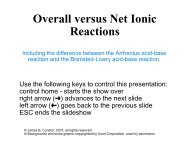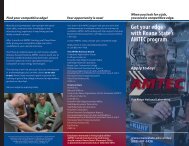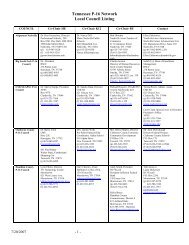2006-2008 Catalog - Roane State Community College
2006-2008 Catalog - Roane State Community College
2006-2008 Catalog - Roane State Community College
Create successful ePaper yourself
Turn your PDF publications into a flip-book with our unique Google optimized e-Paper software.
7111-<strong>Roane</strong>StCommColl 6/16/06 2:58 PM Page 211<br />
ROANE STATE COMMUNITY COLLEGE 211<br />
EDU 231—Field Experiences I. . . . . . . . . . . . . . . . . . . . . . . . . . . . . . . . . . . 2 Credits<br />
EDU 232—Field Experiences II . . . . . . . . . . . . . . . . . . . . . . . . . . . . . . . . . . 2 Credits<br />
A cooperative classroom experience for the student and local school systems. Student exposure<br />
to duties, responsibilities, and requirements of the teaching profession. (Prerequisite: EDU 101<br />
or permission of instructor) F, Sp<br />
EDU 240—Children’s Literature . . . . . . . . . . . . . . . . . . . . . . . . . . . . . . . . . 3 Credits<br />
A survey course dealing with readings and discussions in developmentally appropriate practice<br />
literature and related activities.<br />
EMERGENCY MEDICAL TECHNOLOGY-PARAMEDIC<br />
*EMT 107—Vehicle Extrication and Rescue . . . . . . . . . . . . . . . . . . . . . . . 3 Credits<br />
This course covers all aspects of vehicle rescue, crash rescue and extrication. The course also<br />
deals with, and stresses personal safety during extrication operations. Facts on late model car<br />
structure and extrication methods and patient protection will be emphasized. Successful completion<br />
of this course allows the student to sit for the certification examination given by the<br />
Tennessee Association of Rescue Squads. F<br />
3 hours lecture<br />
EMT 109—First Responder . . . . . . . . . . . . . . . . . . . . . . . . . . . . . . . . . . . . . 4 Credits<br />
This initial training course in the art of pre-hospital emergency medical care follows the guidelines<br />
set by the Department of Transportation (D.O.T.). Successful completion enables the student<br />
to sit for licensure examination given by the Department of Health and Environment,<br />
Division of Emergency Medical Services. First Responders are individuals trained to assess patients,<br />
use AEDs, provide emergency care, and when necessary, move patients without causing<br />
injury. This class is 60 hours long—16 hours are lab. (Prerequisite: Students must have a current<br />
Health Care Provider level CPR card.) F, Sp, Su<br />
Combination lecture/lab (4 hours/week)<br />
*EMT 114—Cave Rescue . . . . . . . . . . . . . . . . . . . . . . . . . . . . . . . . . . . . . . . 4 Credits<br />
This course is designed to familiarize rescue and EMS personnel with the proper techniques for<br />
negotiating entrance and in-cave pits. Students will learn how to select and assemble their personal<br />
vertical and horizontal caving equipment, rig, rappel and ascend drops in a safe manner.<br />
*EMT 115—Advanced Cardiac Life Support - ACLS . . . . . . . . . . . . . . . . 1 Credit<br />
An introduction to common medical emergencies encountered by pre-hospital care providers.<br />
Emphasis is on the recognition and management of emergencies relating to the respiratory and<br />
cardiovascular systems. Students must show proficiency in EKG recognition and the advance<br />
treatment of the patients in cardiopulmonary arrest. Upon successful completion of this course,<br />
students will be ACLS trained by the American Heart Association. This course is available to<br />
EMTs, paramedics, nurses, respiratory therapists, and physicians.<br />
*EMT 116—Basic Trauma Life Support - BTLS . . . . . . . . . . . . . . . . . . . . 1 Credit<br />
A study of the assessment and treatment of victims suffering traumatic injury. Emphasis is on<br />
airway maintenance with cervical spine immobilization and currently accepted treatments for<br />
life threatening injuries related to the cardiopulmonary, musculo-skeletal, gastro-intestinal, and<br />
nervous systems. Upon successful completion of the BTLS course, students will receive certification<br />
by the Tennessee Chapter of the American <strong>College</strong> of the Emergency Physicians. This<br />
course is available to EMTs, paramedics, nurses, respiratory therapists, and physicians.<br />
*EMT 117—Pediatric Advanced Life Support - PALS. . . . . . . . . . . . . . . . 1 Credit<br />
A study of medical and trauma emergencies as related to pediatric patients. Emphasis is on the<br />
assessment and treatment of children by the health care provider in a pre-hospital setting.<br />
Diseases commonly associated with children such as epiglottis, croup, asthma, and febrile<br />
seizures are discussed. The specific areas of obstetrical emergencies and neonate care are included.<br />
Upon completion of the PALS course, students will receive certification by the<br />
American Heart Association. This course is available to EMTs, paramedics, nurses, respiratory<br />
therapists and physicians.<br />
Course Descriptions




